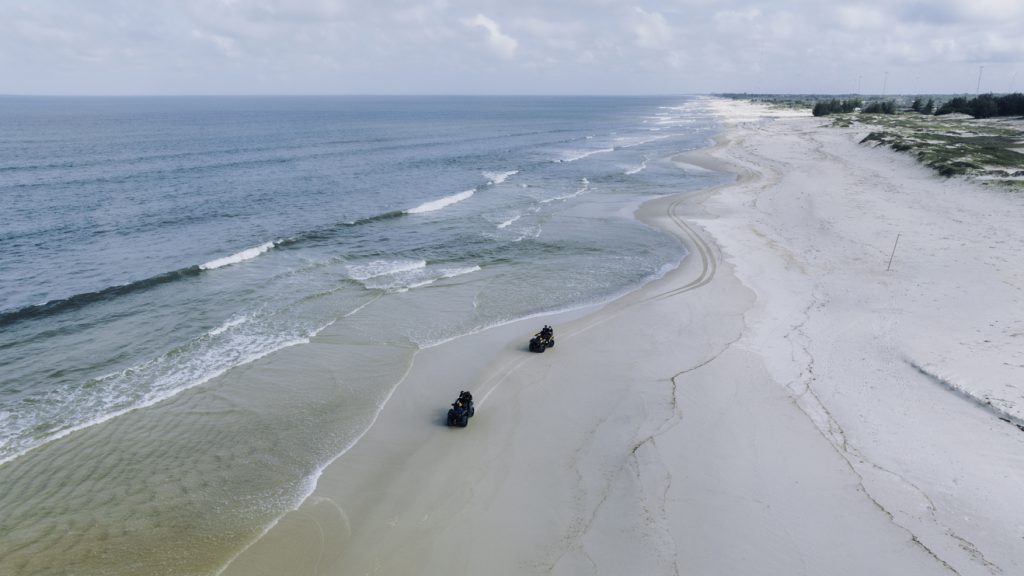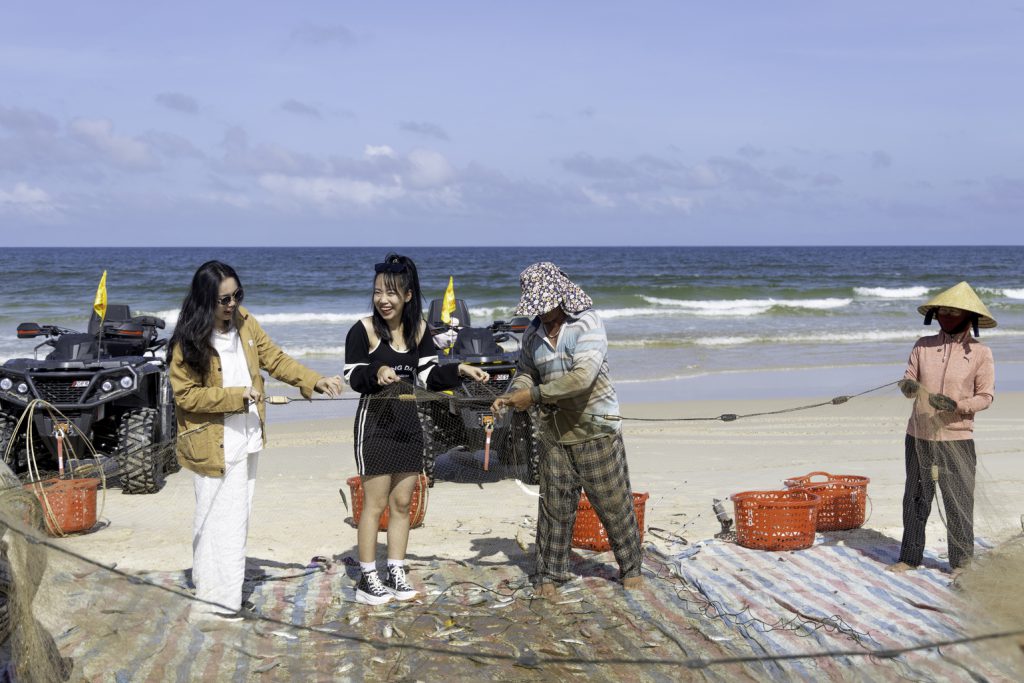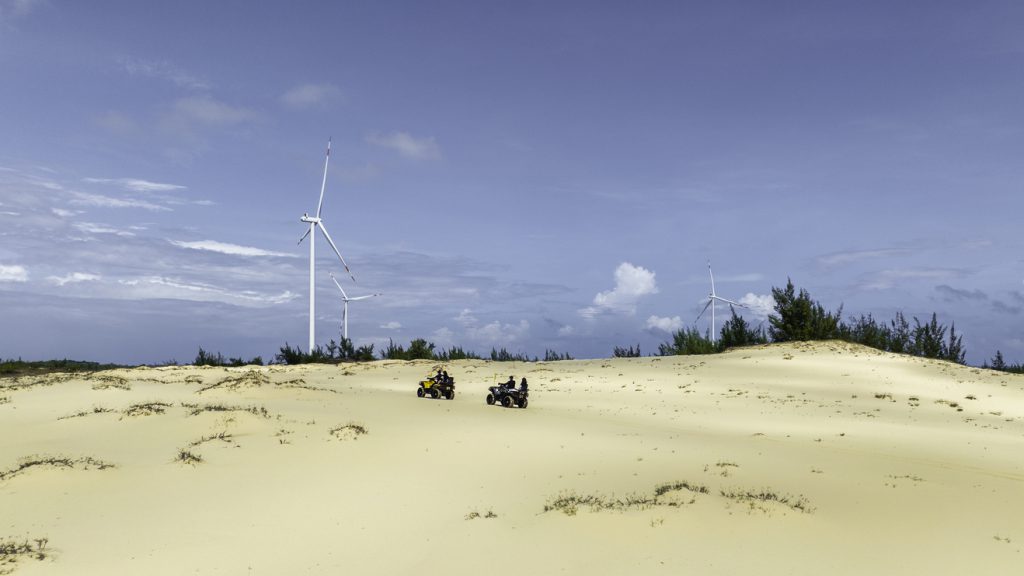Hoang Bui
Whenever Quang Binh is mentioned, generations imagine the sand dunes described in the poem “Mother Suot” by To Huu. The dunes began in Nhat Le Estuary and stretched endlessly. From Bao Ninh to Hai Ninh, the sand was golden and scorching, as described in the lines: “…some dunes of gold sand, some trails with red dust…”

That was many years ago. Today, the dunes have changed a lot. From Bao Ninh to Hai Ninh, the landscape in this sandy region teems with life. It feels youthful and dynamic, with new construction, stylish houses, and bright lights indoors and out, even on the boats and at sea. This region is pulsing with vitality as people work to create a vibrant new way of life.
On a beautiful morning, the sun turned the sea’s surface a sparkly silver. My friends and I decided to explore the sand dunes on ATVs. From Bao Ninh Beach Square, we followed the waves along the coast to Hai Ninh village. The sea breeze blew salty air, tousling our hair. The sand dunes were full of spiky flowering wild plants that look like sea urchins, called lông chông flowers (Campanulaceae). In the wind, these plants rolled around as if they were racing our convoy of vehicles. Startled by the sounds of our engines, ghost crabs (Ocypode ceratophthalma) dashed into small holes in the dunes. Old, gnarled casuarina trees swayed in the wind.

After driving for over 30 minutes, small coastal hamlets came into view. At the first turn, we followed a concrete road to Hai Ninh village. Once a poor village in this sandy region, the locals have learned to “turn gravel into cassava and rice”. During the rainy season, people eagerly dig into the sand to grow crops. Strangely, the cassava and sweet potatoes grown in this sand have a unique nutty flavor found nowhere else. The villagers told me that in the past, root vegetables were eaten instead of rice, and root vegetables, pumpkins, and gourds were their main food source. They soaked the root vegetables in a bowl and poured in pumpkin soup cooked with sea crabs. That sweetness still lingers to this day.
“Giêng hai khoai bầu” is a proverb in the local dialect that relates to the region’s cuisine and former poverty. Nowadays, “sand village sweet potatoes” have become a special folk dish served to visitors from near and far. Khoai deo is a specialty of Quang Binh province, consisting of sliced and dried sweet potatoes. Stopping at the largest khoai deo processing facility in the village, we couldn’t help but marvel at the workers’ speed and urgency.
I struck up a conversation with some sincere locals, who shared stories of their craft. After harvesting, the sweet potatoes are covered with a blanket for three to five days to allow the sugars to settle, before being washed, cooked, peeled, sliced, and dried in the sun until they are chewy and sweet. While this sounds simple, watching the process it’s apparent that this sweet and delicious snack results from these farmers’ cleanliness, dedication, and hard work over days and months. Now beautifully packaged, khoai deo is bought by visitors and enjoyed all over the country.

To meet market demand, many khoai deo workshops in Hai Ninh have invested in dryers, allowing the sweet potatoes to be processed without sunlight.
Hai Ninh village has seen many changes, especially as a “wind power field” has sprung up. Giant wind turbines are nestled between sand dunes and lakes to create a poetic “little desert” that’s popular with young tourists posing for selfies.
The wind turbines are reflected in the shimmering lakes, which are surrounded by an expanse of white sand. After posing for photos with our ATVs, we rode around the turbines to admire them. Our group stopped at a seaside restaurant when the sun was at its highest. Lunch was a simple bowl of noodles with shrimp and squid caught just offshore the village. After eating, we all found a hammock to lie in and swayed in the cool sea breeze.
The waves whispered their eternal story of the sea and the people. For centuries, the sea has provided fresh seafood for coastal residents. The people of Hai Ninh are no exception. They live on the sand but do not rely on one single occupation. Many people in Hai Ninh also work at sea. They have counted on the sea for their livelihood for generations. Along the village’s beach, countless boats were lined up after a night of fishing.
Our ATVs took us back, the engine noises crashing against the waves and blending with the melodious sounds of the wind in the casuarina forest that shields the dunes on the sea’s edge. The sand clung to our clothes. It was a short but satisfying trip, full of new and strange experiences in the sand dunes.










